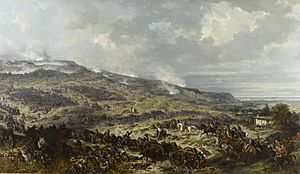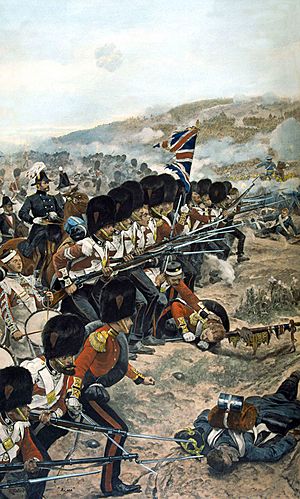Battle of the Alma facts for kids
Quick facts for kids Battle of the Alma |
|||||||
|---|---|---|---|---|---|---|---|
| Part of the Crimean War | |||||||
 Battle of the Alma by Eugene Lami |
|||||||
|
|||||||
| Belligerents | |||||||
| Commanders and leaders | |||||||
| Strength | |||||||
| 56,500–58,000 | 37,500 | ||||||
| Casualties and losses | |||||||
| 4,103 killed and wounded | ~5,000 killed and wounded | ||||||
The Battle of the Alma was a major fight during the Crimean War. It happened on September 20, 1854, near the Alma River in Crimea. This battle was between an alliance of French, British, and Ottoman (Turkish) soldiers and the Russian army.
The allied forces had just landed in Crimea a few days earlier. Their goal was to capture the important port city of Sevastopol. Russian commander Alexander Sergeyevich Menshikov quickly moved his troops. He wanted to stop the allies at the Alma Heights, a strong natural defense spot before Sevastopol.
The battle involved several attacks from the allied side. The French surprised the Russians by climbing steep cliffs. The British then attacked the main Russian positions. After fierce fighting, the British used their better rifles to push the Russians back. With both sides of their army being attacked, the Russians had to retreat. The allies won the battle, but they couldn't chase the Russians far.
Around 1,600 French soldiers were hurt or killed. The British lost about 2,000, and the Ottomans 503. The Russian army suffered about 5,000 casualties.
Contents
Why the Battle Happened
The Crimean War was a conflict between Russia and an alliance of countries. These included the Ottoman Empire, France, and Britain. The war was mainly fought over control of lands near the Black Sea.
In September 1854, a large allied fleet of 400 ships left Varna. They were heading for Crimea, but their exact landing spot was a secret. The allies planned to capture Sevastopol, a key Russian naval base. They landed at Kalamita Bay, about 45 kilometers (28 miles) north of Sevastopol.
Russian commander Alexander Sergeyevich Menshikov was surprised. He didn't expect an attack so late in the year. His army in Crimea was not ready. The allied forces started landing on September 14. The French troops landed quickly with their cannons. The British landing took longer, especially for their horses.
Many British soldiers were sick with cholera. They had to be carried off the ships. There were no easy ways to move supplies on land. Soldiers had to find carts from local farms. They also had no tents or extra supplies. They spent their first nights without shelter in the rain and heat.
After six days, on September 19, the allied army began marching south. The French were closer to the coast, with the Ottoman troops behind them. The British were further inland. They had to cross five rivers on their way to Sevastopol.
Setting the Scene at Alma
The allied army first saw Russian soldiers near the Bulganak River. A small fight happened between Cossack riders and British scouts. The next morning, the allied army marched to the Alma River. The Russian forces were waiting on the high ground on the other side.
Prince Menshikov chose the Alma Heights as his defense spot. Even though the Russian army had fewer soldiers (35,000 Russians versus 60,000 allies), the hills were a strong natural defense. This was the last natural barrier before Sevastopol. The Russians also had over one hundred cannons on the heights. These cannons could fire down on the allies. However, they didn't place any cannons on the very steep cliffs facing the sea. They thought no one could climb them.
The Alma River had steep cliffs on its southern bank. These cliffs were about 350 feet (107 meters) high. They stretched inland for almost 3 kilometers (2 miles). Further inland were two other important hills: Telegraph Hill and Kourgane Hill. Kourgane Hill was a very strong point. It had two forts, called redoubts, to protect it. The road to Sevastopol ran between these hills. Russian cannons were placed to guard this road.
The Battle Begins
By mid-morning, the allied armies were getting ready. The British were on the left, and the French and Ottoman troops were on the right. The plan was for both armies to attack at the same time. They would try to go around the Russian army's sides.
But at the last minute, the British commander, Lord Raglan, decided to wait. He wanted to see if the French attack would succeed first. So, the British soldiers lay on the ground. They were within range of the Russian cannons. They waited for over an hour, losing men as the Russian guns fired at them.
French Attack on the Russian Left
While the British waited, the French on the far right moved forward. General Bosquet's division reached the river. They faced the very steep cliffs that the Russians thought were impossible to climb. The French soldiers, called Zouaves, took off their heavy gear. They swam across the river and quickly climbed the cliffs. They used trees to help them get up.
Once on top, they hid and fought the Russian soldiers. More French soldiers climbed up and brought 12 cannons with them. They arrived just as the Russians were moving more troops to stop them. The Russian commander, Menshikov, was trying to prevent his army from being outflanked.
The Russian situation became difficult. Soon, Bosquet's entire division and many Ottoman soldiers were on the plateau. The Russians had more cannons, but the French cannons were bigger and could shoot further. French riflemen kept the Russian gunners away. Also, cannons from the allied ships started firing at the Russian positions. This made the Russian soldiers lose courage. The Russian regiments began to retreat.
British Attack on the Center
Meanwhile, the French divisions in the center were stuck. They couldn't cross the river because of heavy Russian fire. Prince Napoleon asked the British to attack and help the French. Lord Raglan was still waiting for the French to break through. But under pressure, he finally agreed.
At 2:45 PM, he ordered the British Light, 1st, and 2nd Divisions to advance. The British army moved in two lines. The first line had the Light Division and the 2nd Division. Behind them was the 1st Division, ready to support.
The British Light Division did not spread out enough. Soldiers from different divisions started mixing together. Once they crossed the river, all order was lost. Companies and regiments became jumbled. The Russians saw this and began firing down the hill. British officers tried to get their men to form lines again, but it was hard. Some soldiers even sat down to eat or drink.
Major-General William Codrington, leading a British brigade, saw the danger. He ordered his troops to fix bayonets and charge. His crowded brigade moved uphill. Officers urged them to charge towards the Russian cannons in the main fort, called the "greater redoubt." As Russian cannons fired, the British kept climbing. Some soldiers even captured two Russian cannons inside the fort.
But they didn't have enough backup. Russian soldiers poured into the redoubt. British buglers sounded the retreat. The Russians charged with bayonets, pushing the British back down the hill.
Second British Attack
By now, the British 1st Division had crossed the river. The Russian soldiers in the redoubt saw the British Guards' Brigade coming. This included the Grenadier Guards, Scots Fusilier Guards, and Coldstream Guards. On the far left was the Highland Brigade, led by Sir Colin Campbell. Campbell believed in charging with bayonets. He told his men not to fire until they were very close to the Russians.
The Scots Fusiliers rushed uphill, making the same mistake as the Light Division. At that moment, the Light Division was running back down from the redoubt. The two groups crashed into each other, breaking the Scots Fusiliers' line. They continued towards the redoubt with only half their numbers. When they were close, the Russians fired a huge volley. The Scots Fusiliers had to retreat all the way back to the river. They stayed there for the rest of the battle.
The other two Guards regiments filled the gap. They refused to charge with bayonets. Instead, they formed lines and fired their powerful Minié rifles at the Russians. This stopped the Russian advance. The Russians were forced back into the redoubt.
Final Moments of the Battle
The Russian army did not have strong defenses for their soldiers and cannons. They couldn't hold their position against the deadly Minié rifles of the British. The British 2nd Division also joined the firing. They could see the Russian gunners from the riverbank and shoot them with their rifles.
As the Russian soldiers and cannons pulled back, the British slowly moved uphill. By 4:00 PM, the allies were closing in from all sides. The British Guards were taking over the last Russian reserves on Kurgan Hill. Codrington's men and other Guards were closing in on the main redoubt. The 2nd Division was pushing up the Sevastopol Road. With the French controlling the cliffs above the Alma, the battle was clearly decided.
The Russians fled in all directions. Officers tried to stop them, but the soldiers were in a panic. Most Russian soldiers retreated in small groups, without their officers. Many did not find their regiments for days. On Telegraph Hill, the French found the abandoned carriage of Menshikov. There were also abandoned picnics and opera glasses, left by people from Sevastopol who had come to watch the battle.
Aftermath and Legacy
The battle was costly for everyone. The French had 1,600 casualties (killed or wounded). The British had 2,000, and the Ottomans 503. The Russians lost about 5,000 soldiers.
The British took two days to help their wounded soldiers. They had no medical supplies. They had to use supply carts to move the injured. The Russian army had to leave their wounded behind. Many injured Russians limped back to Sevastopol over several days. About 1,600 wounded had to wait days before they could sail to a hospital in Constantinople.
The allied commanders did not know how many Russians had been hurt. Collecting all the equipment scattered on the battlefield also slowed them down. And because they had no cavalry (horse soldiers), they couldn't chase the retreating Russians right away.
The Battle of the Alma is remembered in several ways. In Paris, France, a bridge is named Pont de l'Alma. In New Zealand, a small town and a river are named Alma. Several places in Canada and the United States, like Alma, New Brunswick and Alma, Michigan, are also named after this battle.




